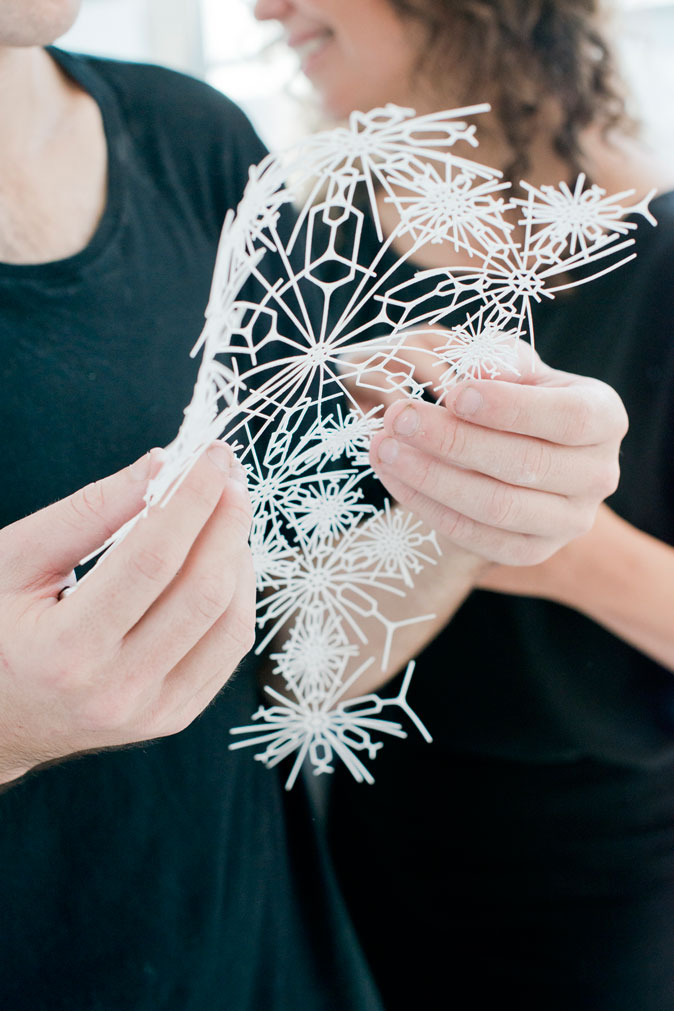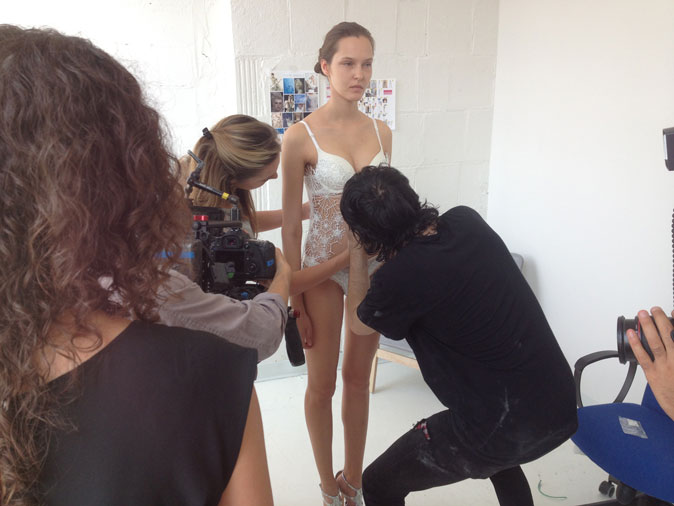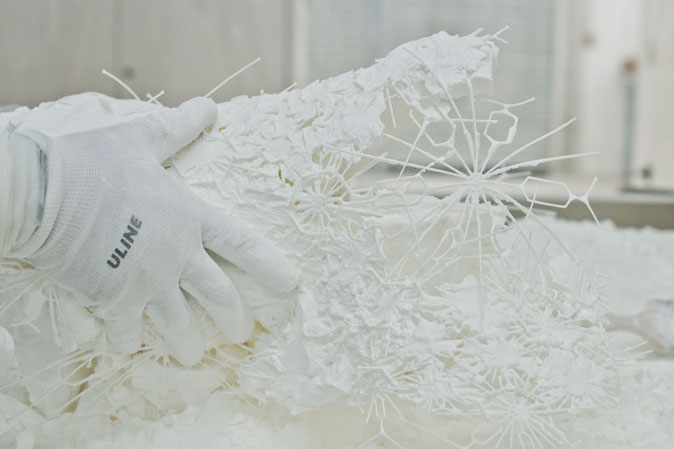
Bradley Rothenberg is who we turned to when Victoria’s Secret
was looking for someone to help design and 3D print the Snow
Queen’s costume for their annual fashion show. 3D printed in the Shapeways
factory in NYC and festooned with thousands of Swarovski crystals, the
fractal snowflake inspired costume is part of the finale of the parade
to be aired on the 10th of December on CBS (don’t forget to tune in!).

We asked Bradley a few questions about the process and how he found
himself designing a costume for Victoria’s Secret’s Snow Queen.
Q: When Victoria’s Secret first approached Shapeways with the concepts
they were looking to explore for the Snow Angels we saw the fractal
nature of the designs and knew they would be a perfect use of the
complexity possible with 3D printing. When they mentioned they were
looking for someone to 3D model the outfit we immediately though of you
with your background in using fractal algorithms in fashion design,
please tell us how you came to explore this from your training in
Architecture?
A: I was lucky enough to work with Vito Acconci whose work was centered
around the intersection of art, Design, & architecture — this led
me to view architecture not just about the built environment, but
utilizing architectural systems throughout a range of scales, the body
being one of them. More specifically, my interest in fractals started
while at pratt: I was introduced to them while taking a studio with
Phillip Beesley, which led me to want to research more the different
form-making possibilities using fractal systems. This continued into my
thesis project at pratt, where we were looking at making
self-replicating spaces that changed based on a users needs — Fractals
are a perfect system for this because of their self-similarity
throughout a range of scales. Recently, I collaborated with Gabi
Asfour, and threeASFOUR for their show MER KA BA, in which we were
really interested in the use of fractals to make interlocking textile’s
using 3D prints.

Read on for more of the story and images that may be considered not safe for work in some instances (it is Victoria’s Secret after all).
Q: When presented with the concept sketches and overall brief, how
did you choose to approach the 3D modeling process to ensure that you
could iterate upon the design to cover the three main criteria,
Victoria’s Secret aesthetic, the exact fit to the Snow Queen and
designing for the 3D printing process? What software did you use to
design the outfits and how long did the modeling process take?
A: My first thought was to come up with a system for generating
fractal snowflakes. We used processing as a tool to sketch different
organizations of snowflakes & how different fractal organizations
allow a shift from small textile-like snowflakes to larger structural
snowflakes. We needed to come up with our own underlying system for
making 3D snowflakes. After testing a series of different, let’s say,
fabric swatches, or the different organizations of snowflakes, it was
then about figuring out how these were organized around the model. For
that, we had Arden Reed 3D scan Lindsay Ellingson…there
was then a back & forth with VS & Shapeways, about how to best
organize the snowflakes into a garment, figuring out where the
snowflakes shift from being more fabric-like to being larger structural
pieces…overall a piece that is completely custom to Lindsay’s body.
The software used for this part of the project were mainly Rhino &
Maya. how long? Probably more time than you probably care to know…

Q: When the designs were starting to be finalized we began 3D
printing prototypes in Nylon using our EOS Selecitve Laser Sintering 3D printers
in our factory in New York to test the structure and fit of the
garments, what surprised you most about the material properties of the
prototype garments and what did you need to do to optimize your designs
for the 3D printing process with Shapeways?
A: What surprised us most was how thin we could actually go with the
material, & how the material performs differently when printed thin
vs thick. The first corset prototype we printed at .8mm, which came
out like a fine lace — It barely held together, & the machines had
to be specifically calibrated to print at such a thin size. We tried to
push the limits of the machine and go as thin as possible for the
corset part, while transitioning to the thicker more structural parts:
the arm & bustle. It was really about finding the right minimum
thickness & working from there to make the structural pieces.

Q: Once the design was finalized Shapeways 3D printed the entire
costume in multiple parts to speed up the printing process and fit the
machines, how many pieces make up the garment from how many
interlocking parts? How was the garment then assembled and fit to the
model?
A: The corset was printed in two pieces, left & right, which
attached to the center-back & bustle structural piece. There were
then two side pieces connecting the bustle to the corset. Additionally,
there were the left & right arm pieces that also tied in to the back
of the corset. Each piece was printed as a number of interlocking
parts that transition into larger structural moments. There were
several fittings testing the different pieces onto the fit model. The
am piece, for instance didn’t quiet fit to the shoulder perfectly in
real life, so we had to take custom measurements of the shoulder, &
re-size the part of the arm piece that sits on the shoulder. It was a
constant back & forth between making adjustments to the digital
model & testing the physical.

Q: Finally, the show is being filmed tomorrow, and will then air
December 10 at 10 p.m. EST on CBS to over 12 million viewers domestically. Additionally, it’s aired in more than 180 countries worldwide, does this make you
nervous or excited and what do you have planned to follow this project?
A: Excited! We have been working on several design projects, but
more importantly, continuing to research the use of 3D printing for
making textiles. We’re starting with bags, & moving to more
clothing pieces soon.
Q: Anything else you would like to say?
This really wouldn’t have been possible without the collaboration between us, Victoria Secret, Shapeways, & Swarovski.
MORE ABOUT BRAD + STUDIO MISSION
studioBRAD is a collaborative design practice located in New York, NY. Established in 2013 by Bradley Rothenberg & Greg Schroy, with Brad Isnard, the studio explores cutting edge design and fabrication techniques to create work that lies between the territories of art, architecture, and fashion. Working with artists and designers employing a variety of unconventional media, studioBRAD aims to inject radical new forms and processes to the made world that redefine boundaries between space, technology, and the body.
BRADLEY ROTHENBERG is a 2009 graduate of Pratt Institute. Prior to forming studioBRAD, he has worked in various architectural environments around the world, including a tenure with Acconci Studio which oversaw the development and execution of pavilions and multimedia installations in Italy, Hong Kong, and Holland. He has collaborated with artists and designers such as Ai Wei Wei, ThreeASFOUR and Katie Gallagher. His independent work has been exhibited at the 2009 Design Miami and the 2010 Hong Kong-Shenzen Biennial.
GREG SCHROY graduated from the Gallitan Department of NYU. Prior to forming studioBRAD, he was a co-owner of the Bamboo Bike Studio & Managing Director of Locke Mountain Ventures.
BRADLEY ISNARD is a 2013 graduate of Pratt Institute. His work has focused on the marriage of art and architecture, and has worked with Snarkitecture and Daniel Arsham on installations and performance pieces before forming studioBRAD. He has helped various artists execute ambitious projects, including a kinetic installation developed with Lourenca Alencar and executed for Hennessy USA. His work has been exhibited at Brooklyn Artist Gym, Pioneer Works and Pratt Manhattan.



If some one wishes to be updated with latest technologies then he must be pay a quick visit this web site
and be up to date all the time.